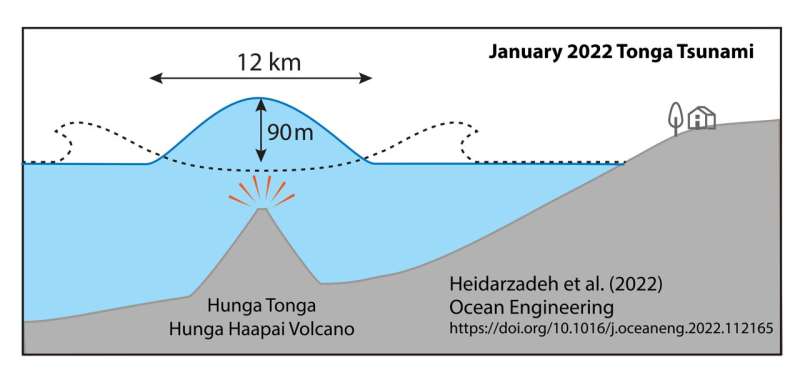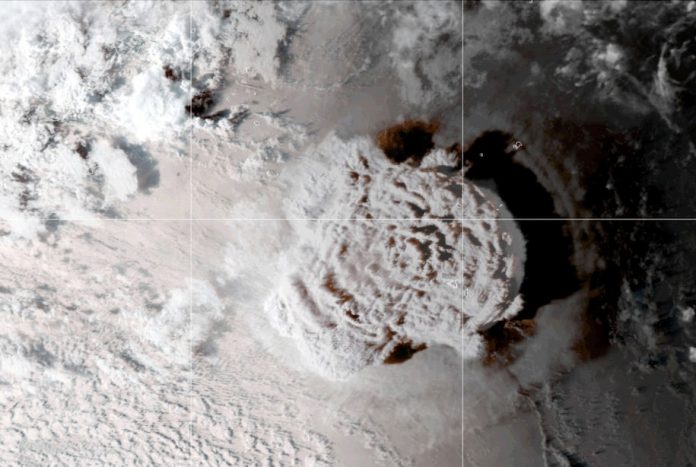The tsunami wave created by the Tonga volcano eruption reached over 90 metres in height, nine times taller than the tsunami that hit Japan in 2011
The Hunga Tonga-Hunga Ha’apai volcano had an eruption in January of 2022, forming an initial wave which was around 90 metres high while releasing more energy than the most powerful nuclear bomb ever detonated. This same tonga volcano eruption has also been known to cause electric currents in space.
The wave formed after the eruption came to be almost the height of the Statue of Liberty (93m), researchers from New Zealand’s GNS Science, the Association for the Development of Earthquake Prediction in Japan, the University of Split in Croatia and London’s Brunel University, found this underwater volcano caused a wave around nine times taller than that from the highly destructive 2011 Japan tsunami.
Calling for better warning systems to detect volcanic eruptions, the University of Bath tsunami experts suggest systems are 30 years behind comparable earthquake detection tools – making detection and safety against active volcanoes more dangerous.
“The eruption should serve as a wake-up call for international groups looking to protect people from similar events in future”

Why was this eruption so unique?
This Tonga volcano eruption was one of the very few tsunamis powerful enough to travel around the globe.
Recorded in all world’s oceans and large seas, from Japan and the United States’ western seaboard in the North Pacific Ocean to the coasts within the Mediterranean Sea, the researchers found that the tsunami was unique as the waves were created not only by the water displaced by the volcano’s eruption but also by huge atmospheric pressure waves, which circled the globe multiple times.
This ‘dual mechanism’ created a two-part tsunami. Initial ocean waves created by the atmospheric pressure waves were followed more than one hour later by a second surge created by the eruption’s water displacement.
This combination meant tsunami warning centres did not detect the initial wave as they are programmed to detect tsunamis based on water displacements rather than atmospheric pressure waves, which cost a lot more lives than necessary to the eruption around Tonga.
After sending atmospheric shock waves, sonic booms, and tsunami waves around the world, researchers discovered the volcano’s effects also reached space, where hurricane-speed winds and unusual electric currents in space, formed in the ionosphere.
Monitoring systems for volcano-based tsunamis are ’30 years behind’
Dr Heidarzadeh says the Tonga tsunami should serve as a wake-up call for more preparedness and understanding of the causes and signs of tsunamis caused by volcanic eruptions. He says: “The Tongan tsunami tragically killed five people and caused large-scale destruction, but its effects could have been even greater had the volcano been located closer to human communities.
“The volcano is located approximately 70 km from the Tongan capital Nuku’alofa – this distance significantly minimized its destructive power.
“This was a gigantic, unique event and one that highlights that internationally we must invest in improving systems to detect volcanic tsunamis as these are currently around 30 years behind the systems we used to monitor for earthquakes. We are under-prepared for volcanic tsunamis.”
The researchers analysed ocean observation data recordings of atmospheric pressure changes and sea level oscillations to find out the Tonga volcano eruption’s effects.
“Monitoring of volcanic activity should be organized, and more high-quality research into volcanic eruptions and areas at hazard is always a good idea”
Dr Aditya Gusman, Tsunami Modeller at the New Zealand-based geoscience service, says: “The 2018 Anak Krakatau volcano and 2022 Hunga Tonga-Hunga Ha’apai volcano eruptions clearly showed us that coastal areas surrounding volcano islands are at risk of being hit by destructive tsunamis.
“Although it may be preferable to have low-lying coastal areas completely clear from residential buildings, such a policy may not be practical for some places as volcanic tsunamis can be considered infrequent events.”
Co-author Dr Jadranka Šepić, from the University of Split, Croatia, adds: “What is important is to have efficient warning systems, which include both real-time warnings and education on what to do in a case of a tsunami or warning – such systems save lives.
“In addition, at volcanic areas, monitoring of volcanic activity should be organized, and more high-quality research into volcanic eruptions and areas at hazard is always a good idea.”











